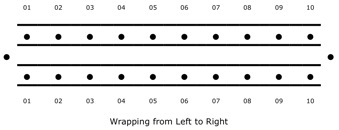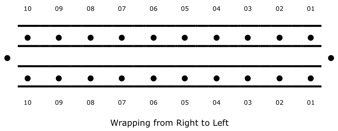Knitting Boards
A knitting board is two parallel rakes. One of the most common knitting boards in use is the Knifty Knitters long looms. These looms are dual purpose in that they can function as a round loom and can function as a knitting board. Other manufacturers sell adjustable looms (AJALs) that act in a similar fashion. Some manufacturers such as Authentic Knitting Boards specialize in making knitting boards. The gauge of a knitting board is determined by two factors:
- The distance between the pegs
- The distance between the two rakes
In addition, different size knitting boards are available for different sizes of hats, bags, scarves, socks, blankets, etc. It's not unusual to see an extra large knitting board in an S-shape to take up less room.
Types of Kntting
You have two options for the type of fabric you can produce with a knitting board:
- Double-Knit: A thick, warm fabric that is created by wrapping and knitting off both pegs in each column across the rakes. Unlike round looms & rakes, you will wrap the entire board for a stitch pattern first and then knit off instead of working each stitch individually. Because of this, needle knitting patterns can be adapted with known stitch patterns. Conversions are possible too, they just take more time. See Knitting Board Considerations in Converting Patterns.
- Single-Knit: A standard knit fabric that is created by knitting on only one rake (see Round Looms & Rakes) or by wrapping and knitting no more than one peg in each column across the rakes.
Numbering System on this Site
To understand how to wrap the pegs for a stitch pattern, you will need to know how the pegs are numbered on the knitting board. If you turn the knitting board on its side so it faces you, the bottom rake has odd numbers starting with 1 on the bottom left and the top rake has even numbers starting with 2 on the upper left. Some knitting boards have anchor pegs located on each side of the knitting board. These are not required for knitting but if yours does not and you like working with one, you can substitute a thumb tack.
Please click the image to enlarge
Wrapping a board for double knit fabric for one row normally takes two passes: half of the pegs are wrapped working from left to right and then the other half are wrapped working from right to left. Wrapping is done by moving back and forth between the two rakes. There are a few wrapping methods that wrap all of the pegs going in one direction for one row and then wrap all of the pegs in the opposite direction for the next row. Directions for the wrapping patterns will note if you need two passes or only one.
Other Numbering Systems
There are two other numbering systems that you
will see in patterns. This site uses the one
above until standards have been developed. You
should be aware of what the other numbering
systems are, though, so you will know how to
adapt the patterns that you purchase to whichever
system you decide works best for you.
The first system numbers the top and bottom rake
with the same numbers in ascending order except
that the top rake uses "A" after the number and
the bottom rake uses "B":

Please click the image to enlarge
The second system numbers the top and bottom rake with the same numbers in ascending order when wrapping from left to right and then numbers then in descending order when wrapping from right to left:


Please click the images to enlarge
There are different ways to look at how the
knitting board works, one of which is presented
here. It was chosen because it makes it easier to
understand both creating double and single knit
fabric across the two rakes of the knitting board.
The diagram below illustrates how the fabric is
put together. Notice that the yarn that runs
between the rakes is a slip stitch (wyib). The
crossed slip stitch intertwines the two fabrics,
allows the stitches in the back fabric to come
forward when there is more than one slipped
stitch, and creates a less dense fabric.

Let's look at two different stitches: the stockinette stitch and the double rib stitch. There are two different wrapping methods for both, diagonal and box.
- Stockinette
- Diagonal: nice airy fabric, evenly spaced since there is a slip in between each stitch. If you gently pull apart the stitches, you will see the slipped stitch.
- Box: densely knit fabric with a slip at every two stitches. The placement of the slip almost makes it look like a rib as it is coming down the knitting board but once it is off, the fabric lays as stockinette.
- Double Rib (picture explanation coming
soon)
- Diagonal: Again, a nice airy fabric that is evenly spaced. The extra slip causes the purled stitches to peek through, making for a ribbed fabric. Notice that the two sides don't exactly match: one side is *k2, p2; rep from *, end k2 and the other side is k3, *p2, k2; rep from star, end k3. If you look at the spacing of the wrapping on each side, you will note that the upper rake skips two pegs starting and ending, causing it to start and end with k2 as opposed with k3 like the other side.
- Box: As with the Stockinette, a more dense fabric due to two stitches being knit next to each other and then a slip. Here, the placement of the slip allows for the purl stitches to show through. Again, both sides do not match. One side is *k2, p2; rep from *, end k2 and the other side is k1, *p2, k2; rep from *, end k1.
Single Knit
So what about single knitting across the two rakes? There is only one fabric so there is a right and wrong side to it. Only one peg is knit off in a column across the rakes. Stitches worked on the bottom rake are knit stitches and stitches worked on the top are purl stitches. When you cross between the rakes, you create a slip stitch just like when you do it in double knitting.Differences between Knitting Board Double Knitting
& Needle Knitting Double Knitting
As described above, double knitting on the knitting
board is done with one strand of yarn and it creates a two
interlocked fabrics by knitting, slipping wyib and then
purling. Two parallel rows are wrapped and worked at one
time. On needles, double knitted is done with two strands
of yarn, often in contrasting colors. It can either create
two interlocked fabrics like the knitting board or it can
create two single-knit fabrics. In theory, you can create
as many fabrics as you have strands of yarn with needles.
There are two methods for creating double knitted fabrics
with needles. One of them is similar to the knitting board
in that it uses slipped stitches. This methods takes longer
than the other ones to work because you have to knit the
row twice. The following describes this method and comes
from the Wikipedia.
Double knitting with slipped
stitches
Slip stitches may be used for an easier method of double
knitting that requires only one yarn be handled at one
time. As a concrete example, consider a two-color pattern
with a multiple of four stitches (labeled ABCD) being knit
on double-pointed circular needles. On the first row, using
color 1, stitch A is knitted, stitch B is purled, stitch C
is slipped wyib and stitch D is slipped wyif. The knitter
then slides the stitches back to the beginning (recall that
the needles are double-pointed). Then, using color 2,
stitch A is slipped wyib, stitch B is slipped wyif, stitch
C is knitted and stitch D is purled. The knitter then turns
the work and repeats indefinitely. The knitted and slipped
wyib stitches come forward, whereas the purled and wyif
stitches recede, resulting in a (very warm!) double-knit
scarf alternating in the two colors with beautiful drape.
The knit and purl stitches produce the front and back
fabrics, respectively, of the double-knitted fabric while
the slipped stitches allow for the alternation of color.
An even simpler slip-stitch pattern generates two fabrics
at once on the same needle. Consider the pattern: * knit 1,
slip 1 wyif *. At the end of the row, turn the work. Then
knit the stitches that were slipped and slip (again wyif)
the stitches that were knitted. In the end, one should
obtain a "pocket" that can be opened (be sure to use wyif
slip-stitches during binding off as well!) The wyif slip
stitch prevents the yarn from crossing over to the back
fabric, so that only the front fabric is knitted in any
row. This is probably the secret technique of Anna
Makarovna from Leo Tolstoy's War and Peace, who always knit
two socks simultaneously
When the pair was finished, she made a solemn ceremony
of pulling one stocking out of the other in the presence of
the children.
(Wikipedia: Slip-stitch knitting,
2007)
In the other method, you work both the front and the back fabrics at the same time. KnittingHelp.com gives an excellent explanation of the method plus it has a video to show you how it is worked. It is found on the page for Advanced Techniques. Scroll down towards the bottom of the page. Stitch Diva also gives a great explanation of this technique.







